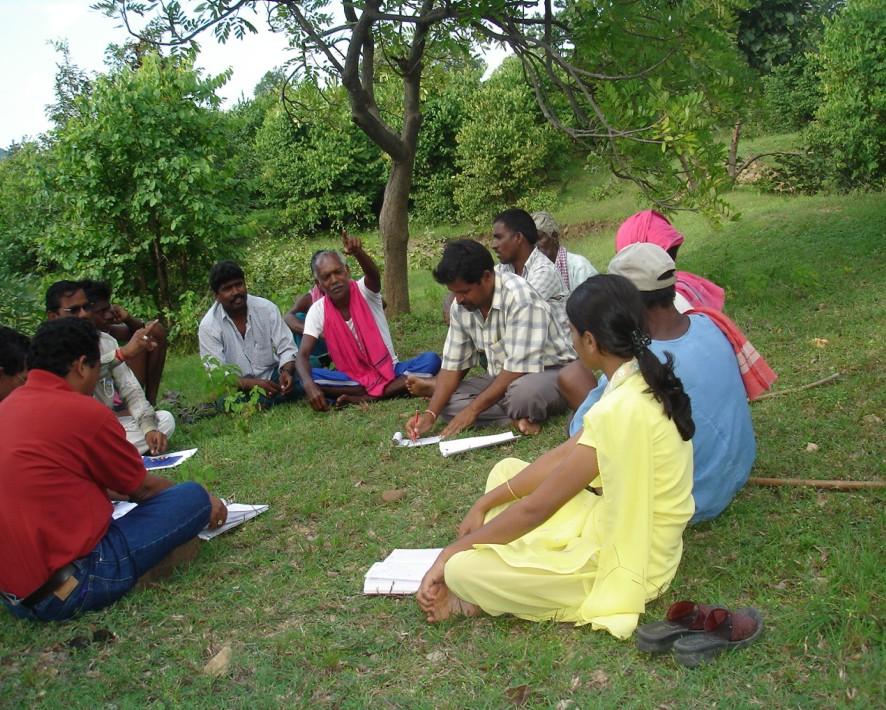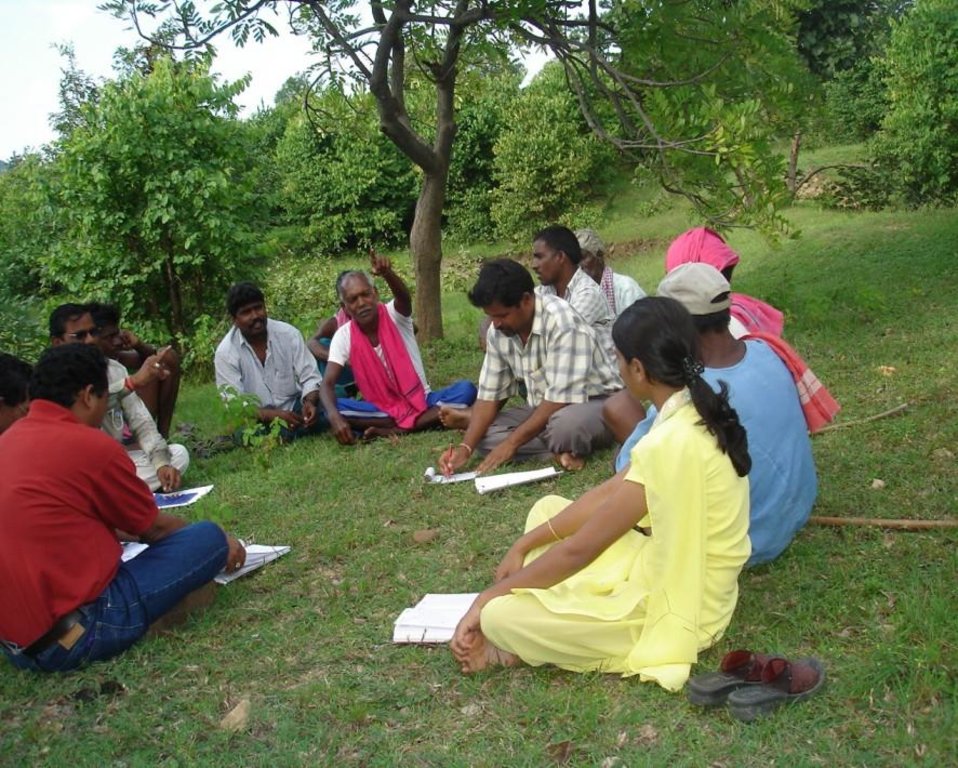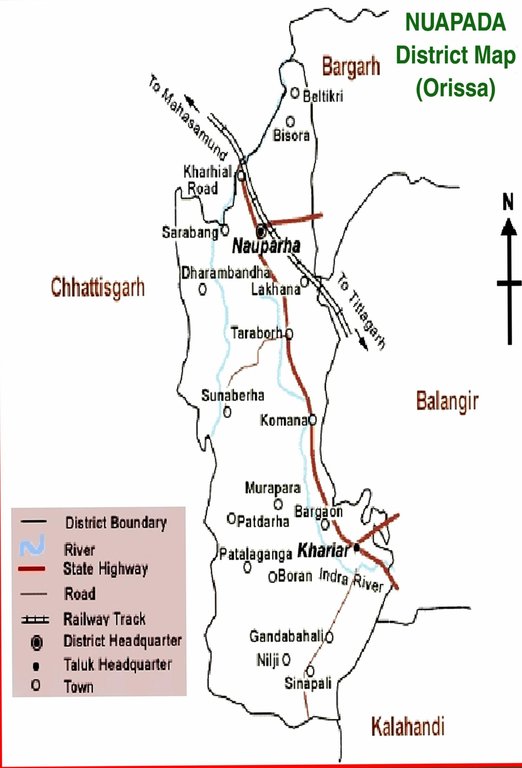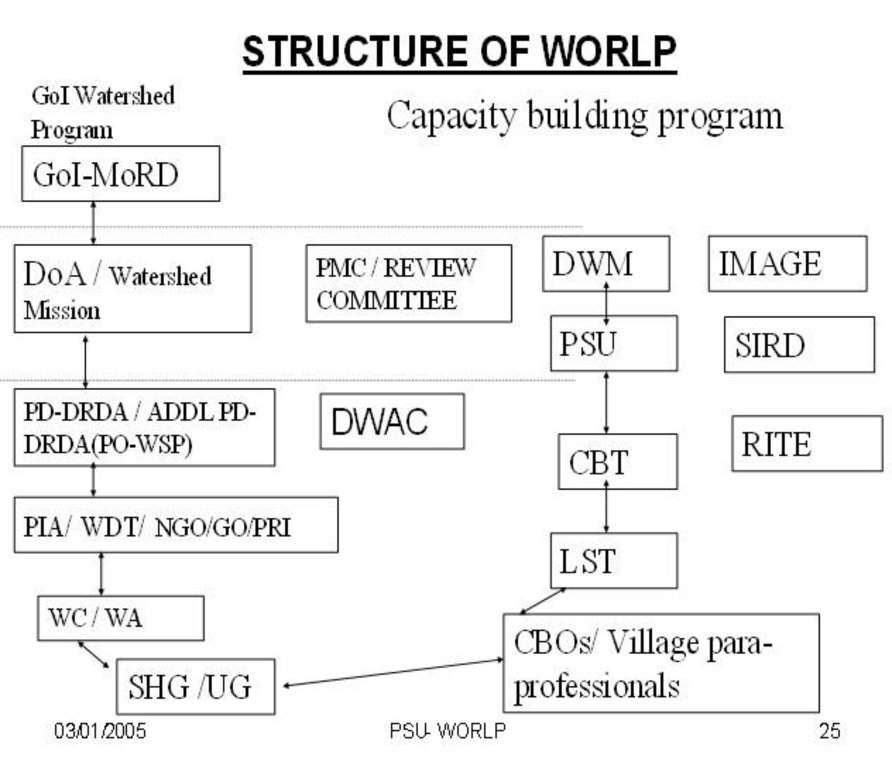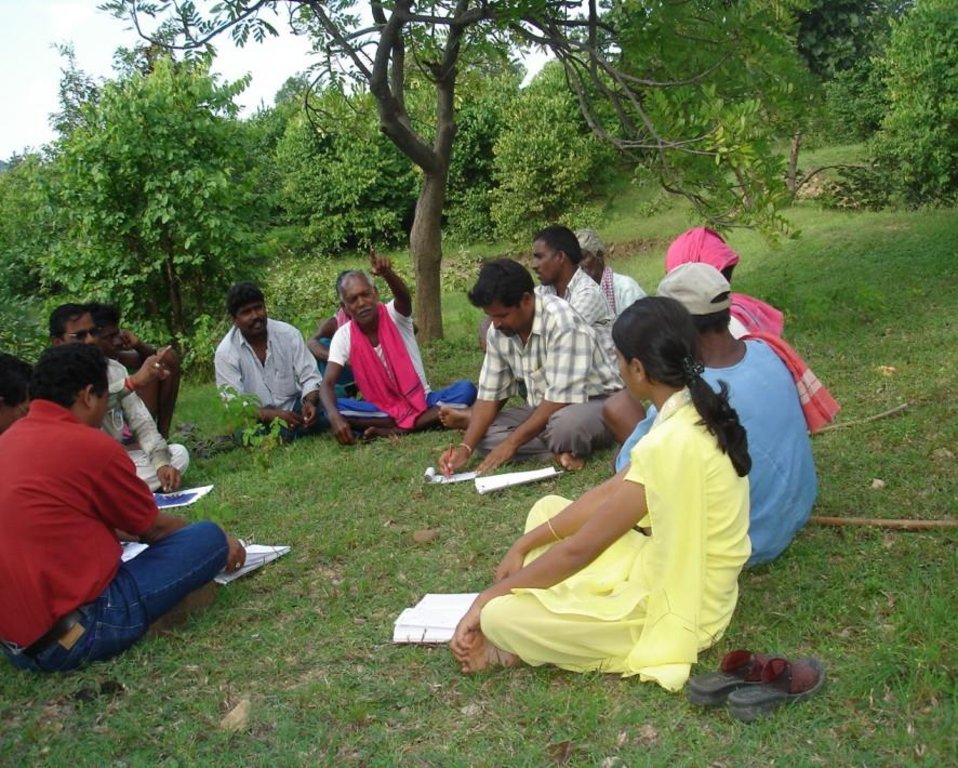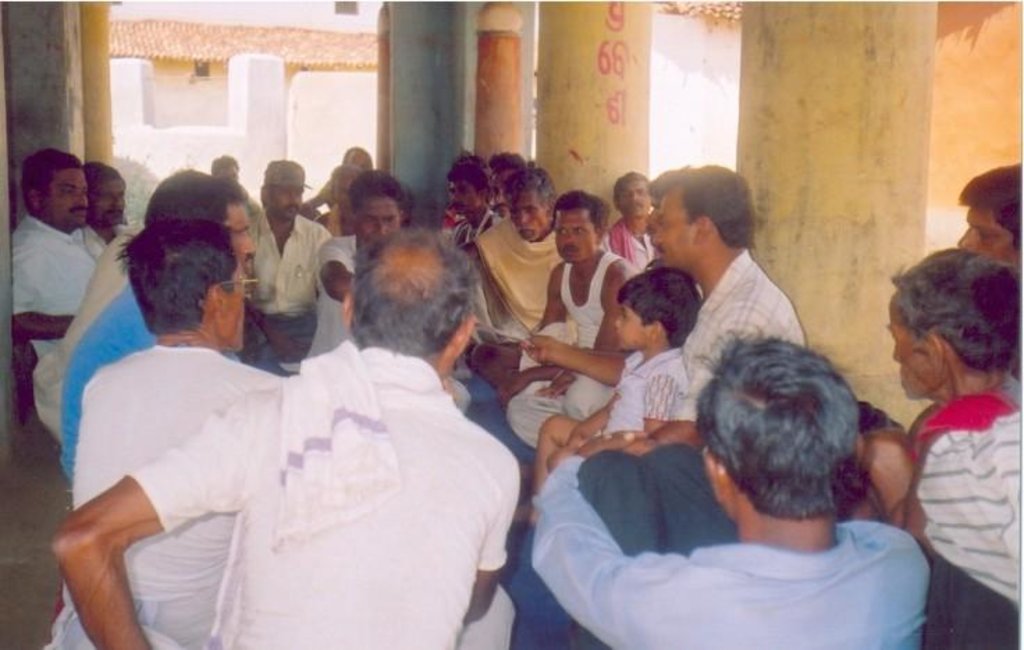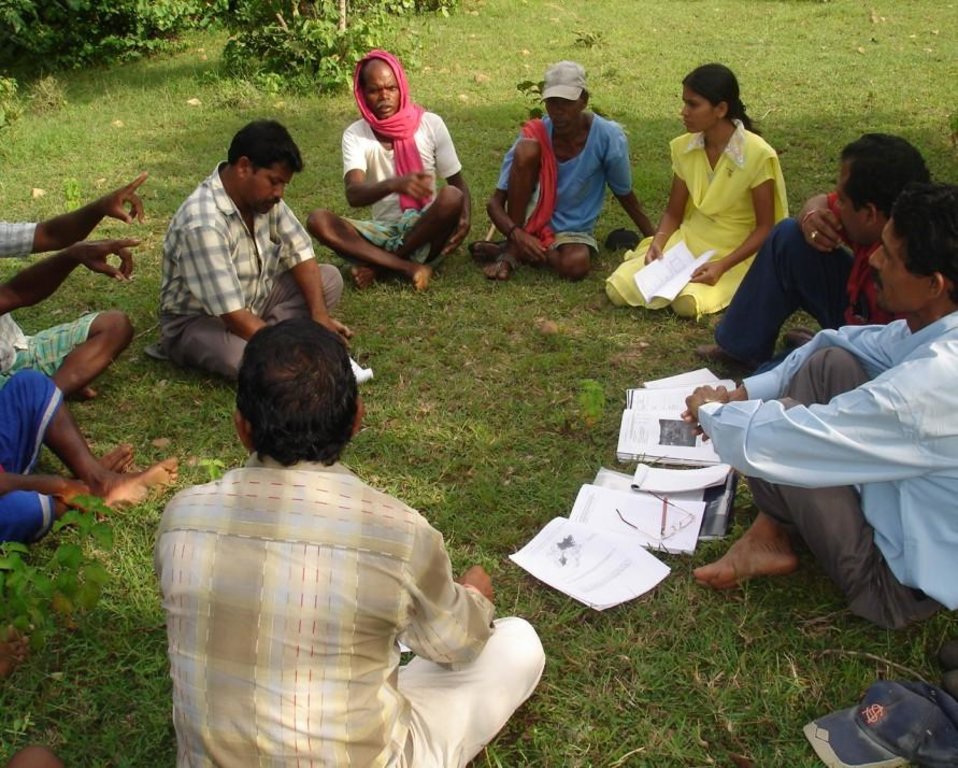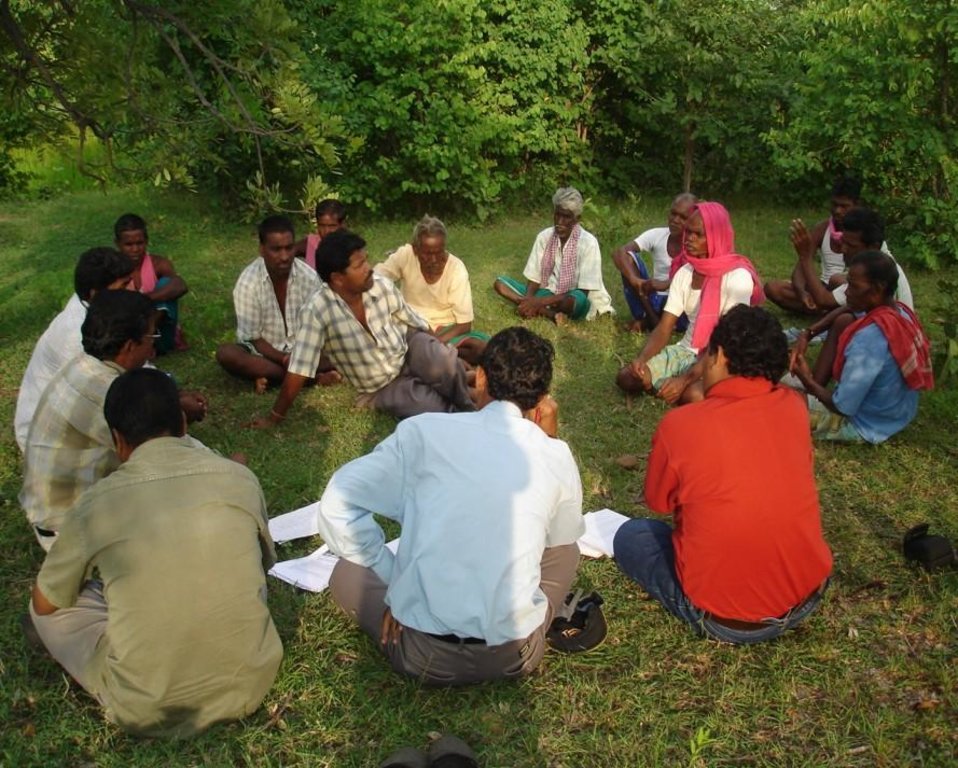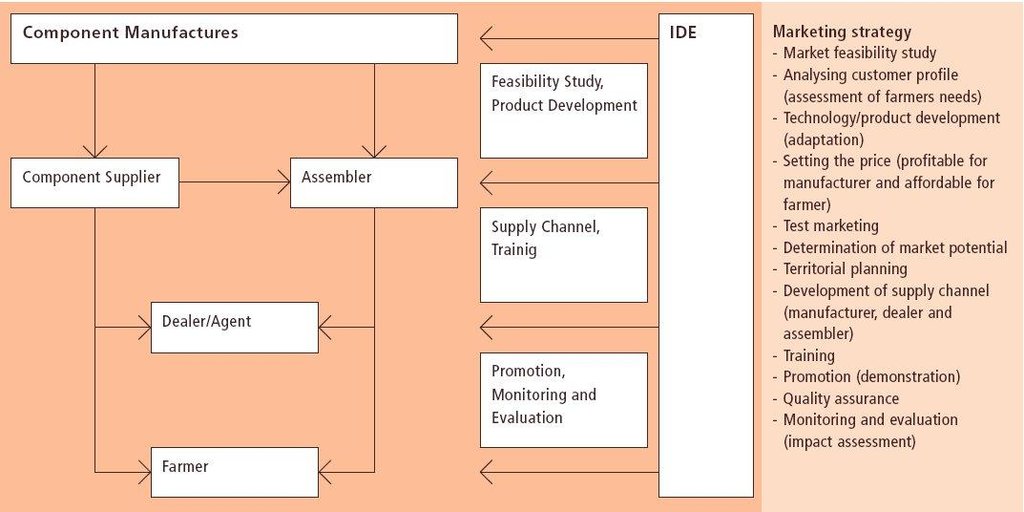Participatory Watershed Development Approach [Inde]
- Création :
- Mise à jour :
- Compilateur : Narendra Kumar Panigrahi
- Rédacteur : –
- Examinateur : Fabian Ottiger
approaches_2368 - Inde
Voir les sections
Développer tout Réduire tout1. Informations générales
1.2 Coordonnées des personnes-ressources et des institutions impliquées dans l'évaluation et la documentation de l'Approche
Nom du ou des institutions qui ont facilité la documentation/ l'évaluation de l'Approche (si pertinent)
Orissa Watershed Developemnt Mission - Inde1.3 Conditions relatives à l'utilisation par WOCAT des données documentées
Le compilateur et la(les) personne(s) ressource(s) acceptent les conditions relatives à l'utilisation par WOCAT des données documentées:
Oui
1.4 Références au(x) questionnaire(s) sur les Technologies de GDT
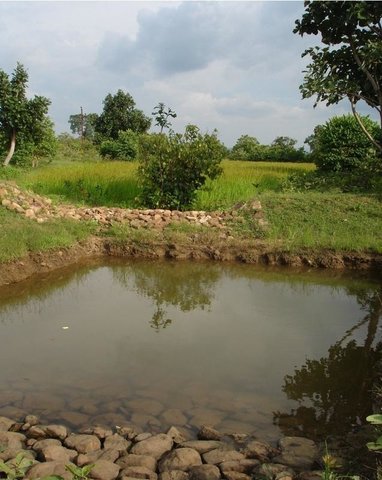
Sunken gully pits [Inde]
Runoff management pit in the gully with provision of waterway for excess runoff water.
- Compilateur : SATYANARAYANA SAHU
2. Description de l'Approche de GDT
2.1 Courte description de l'Approche
Livelihood asset base development through participatory watershed developemnt keeping people at the center stage of development and promoting village level institutions.
2.2 Description détaillée de l'Approche
Description détaillée de l'Approche:
Aims / objectives: Livelihoods improvement through asset building; Capacity building, Enabling environment, Village level institutions building, Natural resource management. Participatory tools are used to do situational analysis and planning. Self Help Groups and User Groups are promoted for taking up micro enterprise and land based activities respectively. Community mobilisation is done using local folk songs and dance.
Stages of implementation: The project is implemented within a five year period. First year is used as rapport building, institution building and preparation of micro plan. The external team plays the role of facilitators and capacity building of the primary stakeholders.
2.3 Photos de l'approche
2.5 Pays/ région/ lieux où l'Approche a été appliquée
Pays:
Inde
Région/ Etat/ Province:
Village- Larki, Block- Komna, Dist.- Nuapada.
Map
×2.6 Dates de début et de fin de l'Approche
Indiquez l'année de démarrage:
2001
Date (année) de fin de l'Approche (si l'Approche n'est plus appliquée):
2010
2.7 Type d'Approche
- fondé sur un projet/ programme
2.8 Principaux objectifs de l'Approche
The Approach focused mainly on SLM with other activities (Productivity enhancement; Income generating programme, Water and sanitation)
1. Livelihood improvement. 2. Poverty Reduction. 3. Increase households(HH) annual income. 4. Eco restoration
The SLM Approach addressed the following problems: Natural calamity ( drought) 2. Poverty 3. Illiteracy 4. Sustanability in agriculture production.5. Economic enhancement of the people.
2.9 Conditions favorisant ou entravant la mise en œuvre de la(des) Technologie(s) appliquée(s) sous l'Approche
normes et valeurs sociales/ culturelles/ religieuses
- entrave
Education, personal conflict, lack of knowledge, skill
Treatment through the SLM Approach: IEC material, Training,Hand holding support.
disponibilité/ accès aux ressources et services financiers
- entrave
Poor financial status of theof community.
Treatment through the SLM Approach: Financial Assistance from the project with little contributioin from the beneficiaries
cadre institutionnel
- entrave
Ugs not functional as desired
Treatment through the SLM Approach: strengthening of the Ugs
cadre juridique (régime foncier, droits d'utilisation des terres et de l'eau)
- entrave
No usufruct right/ownership on CPR land
Treatment through the SLM Approach: Users right/ usufrut right to the UG
The existing land ownership, land use rights / water rights hindered a little the approach implementation Fragmentated land ownership with low land holding dinder the implementation of the approach.
connaissances sur la GDT, accès aux supports techniques
- entrave
Unable to perceive real problem because of technical failures
Treatment through the SLM Approach: Technical problem analysis with the community
3. Participation et rôles des parties prenantes impliquées dans l'Approche
3.1 Parties prenantes impliquées dans l'Approche et rôles
- Spécialistes de la GDT/ conseillers agricoles
Working land users were mainly men (Most men are engaged in landbased activities.) Women are not capacitated to putforth their views in community meeting. Women are not free enough to say something due to socio-cultural hindrance. Women are not empowered to participate along with the men in public meeting. As per the guideline Land Less(LL) and Very Poor (VP) are included in Watershed Development Committee(WDC) for decision making.
- ONG
- gouvernement national (planificateurs, décideurs)
Govt. agency
- organisation internationale
3.2 Participation des exploitants locaux des terres/ communautés locales aux différentes phases de l'Approche
| Participation des exploitants locaux des terres/ communautés locales | Spécifiez qui était impliqué et décrivez les activités | |
|---|---|---|
| initiation/ motivation | passive | public meetings; Lack of awareness about the SWC measures. |
| planification | interactive | Mainly: rapid/participatory rural appraisal; partly: interviews/questionnaires; Conceptual clarity regarding SWC & its benefits |
| mise en œuvre | soutien extérieur | Mainly: casual labour; partly: responsibility for minor steps; Engaged as daily wage labourer. Extends cooperation in non-monetary activities |
| suivi/ évaluation | interactive | Mainly: public meetings; partly: interviews/questionnaires; 1. Evaluation of field work through measurement. 2. Transperancy on expenditure and programme. |
| Research | passive |
3.3 Diagramme/ organigramme (si disponible)
3.4 Prises de décision pour la sélection de la Technologie/ des Technologies
Indiquez qui a décidé de la sélection de la Technologie/ des Technologies à mettre en œuvre:
- principalement les exploitants des terres soutenus par des spécialistes de la GDT
Expliquez:
The problems are discussed while doing transect in the watersheds. Solutions aby the users as well as the SWC specialists are discussed. The consensus is arrived on the technology which land users can accept, adopt and maintain.And the technology do not put pressure on the natural environment.
Decisions on the method of implementing the SLM Technology were made by mainly by land users supported by SLM specialists. During the MLP,transect is carried along with the land users and options were discussed with the land users. Then they choose the best option after analysing the opportunities and constraints.The UG implement the technology. This has been laid down in t
4. Soutien technique, renforcement des capacités et gestion des connaissances
4.1 Renforcement des capacités/ formation
Une formation a-t-elle été dispensée aux exploitants des terres/ autres parties prenantes?
Oui
Spécifiez qui a été formé:
- exploitants des terres
- SWC specialists, teachers (2), extensionists/trainers (1), planners (3)
Formats de la formation:
- sur le tas
- entre agriculteurs (d'exploitants à exploitants)
- zones de démonstration
Thèmes abordés:
Class room as well as on farm training provided to land users.
4.2 Service de conseils
Les exploitants des terres ont-ils accès à un service de conseils?
Oui
Spécifiez si le service de conseils est fourni:
- dans des centres permanents
Décrivez/ commentez:
Name of method used for advisory service: Participatoy extension methods and exposure to successful fields, demo plotsl; Key elements: Seeing is beleiving and learning by doing; 1) Mainly: Through change agents(Community Link Workers), Partly: government's existing extension system 2) Mainly: Through change agents(Community Link Workers), Partly: government's existing extension system; Extension staff: specifically hired project employees 3) Target groups for extension: land users; Activities: To expertise and replicate
Advisory service is inadequate to ensure the continuation of land conservation activities; Extensioin programme relating to production aspects of the technology is not adequate.
4.3 Renforcement des institutions (développement organisationnel)
Des institutions ont elles été mises en place ou renforcées par le biais de l'Approche?
- oui, modérément
Spécifiez à quel(s) niveau(x), ces institutions ont été renforcées ou mises en place:
- local
Précisez le type de soutien:
- financier
- renforcement des capacités/ formation
- équipement
4.4 Suivi et évaluation
Le suivi et l'évaluation font ils partie de l'Approche? :
Oui
Commentaires:
bio-physical aspects were regular monitored through observations
technical aspects were regular monitored through measurements
socio-cultural aspects were regular monitored through observations
economic / production aspects were regular monitored through measurements
area treated aspects were regular monitored through observations
no. of land users involved aspects were regular monitored through measurements
management of Approach aspects were regular monitored through observations
There were few changes in the Approach as a result of monitoring and evaluation: Increased participation and ownership. User groups are strengthened. Viewsa of the Users respected and involved in decision making.
4.5 Recherche
La recherche a-t-elle fait partie intégrante de l’Approche?
Oui
- Participatory and action research
Donnez plus de détails et indiquez qui a mené ces recherches:
Participatory technology development through IDEI and action research with independent consultancy firms have been initiated. But relating to approach research study have not been initiated. This is infant stage.
Research was carried out on-farm
5. Financement et soutien matériel externe
5.1 Budget annuel de la composante GDT de l'Approche
Si le budget annuel précis n'est pas connu, indiquez une fourchette:
- 10 000-100 000
Commentez (par ex. principales sources de financement/ principaux bailleurs de fonds):
Approach costs were met by the following donors: government (national - MoRD): 100.0%
5.2 Soutiens financiers/ matériels fournis aux exploitants des terres
Les exploitants des terres ont-ils reçu un soutien financier/ matériel pour la mise en œuvre de la Technologie/ des Technologies?
Oui
5.3 Subventions pour des intrants spécifiques (incluant la main d'œuvre)
- équipement
| Spécifiez les intrants subventionnés | Dans quelle mesure | Spécifiez les subventions |
|---|---|---|
| outils | en partie financé | |
- intrants agricoles
| Spécifiez les intrants subventionnés | Dans quelle mesure | Spécifiez les subventions |
|---|---|---|
| Biocides | en partie financé | |
- infrastructures
| Spécifiez les intrants subventionnés | Dans quelle mesure | Spécifiez les subventions |
|---|---|---|
| community infrastructure | en partie financé | |
Commentaires:
UG
5.4 Crédits
Des crédits ont-ils été alloués à travers l'Approche pour les activités de GDT?
Non
6. Analyses d'impact et conclusions
6.1 Impacts de l'Approche
Est-ce que l'Approche a aidé les exploitants des terres à mettre en œuvre et entretenir les Technologies de GDT?
- Non
- Oui, un peu
- Oui, modérément
- Oui, beaucoup
The SWC measures are maintained by the land users. The utilisation of water resource through adoption of cropping systems. Multiple cropping adopted in stead of mono cropping.
Est-ce que l'Approche a amélioré les questions foncières et des droits d'utilisation qui entravent la mise en œuvre des Technologies?
- Non
- Oui, un peu
- Oui, modérément
- Oui, beaucoup
Community mobilisation & participatory planning reduces the problem to some extent.Group activities are initiated to strengthen community. The problem is likely to be overcome in the near future.
Did other land users / projects adopt the Approach?
- Non
- Oui, un peu
- Oui, modérément
- Oui, beaucoup
Other watershed project have replicated the best pracitces adopted in this approach.
6.3 Durabilité des activités de l'Approche
Les exploitants des terres peuvent-ils poursuivre ce qui a été mis en œuvre par le biais de l'Approche (sans soutien extérieur)?
- oui
6.4 Points forts/ avantages de l'Approche
| Points forts/ avantages/ possibilités du point de vue de l'exploitant des terres |
|---|
| Views and opinion of the beneficiaries are considered (How to sustain/ enhance this strength: Regular follow- up.) |
| Points forts/ avantages/ possibilités du point de vue du compilateur ou d'une autre personne ressource clé |
|---|
| 1.Community Organisation (How to sustain/ enhance this strength: Strengthen village level institutions) |
| 2. Participatory Approaches (How to sustain/ enhance this strength: Institutionalise processes) |
| 3. Monitoring (How to sustain/ enhance this strength: Strengthen community monitoring) |
| 4. Evaluation (How to sustain/ enhance this strength: Evaluation by both internal and external agency) |
| 5. Ownership (How to sustain/ enhance this strength: User rights ensured, Community Fund Sustainably utilised) |
6.5 Faiblesses/ inconvénients de l'Approche et moyens de les surmonter
| Faiblesses/ inconvénients/ risques du point de vue de l’exploitant des terres | Comment peuvent-ils être surmontés? |
|---|---|
| Coherence among group members | How to make the groups self sustainable? This needs to be addressed by providing financial freedom, decision making opportunities,vision building through exposure to better groups |
| Faiblesses/ inconvénients/ risques du point de vue du compilateur ou d'une autre personne ressource clé | Comment peuvent-ils être surmontés? |
|---|---|
| Facilitators attitude | Capacity building programme for the facilitators |
7. Références et liens
7.1 Méthodes/ sources d'information
- visites de terrain, enquêtes sur le terrain
- interviews/entretiens avec les exploitants des terres
Liens et modules
Développer tout Réduire toutLiens

Sunken gully pits [Inde]
Runoff management pit in the gully with provision of waterway for excess runoff water.
- Compilateur : SATYANARAYANA SAHU
Modules
Aucun module trouvé


